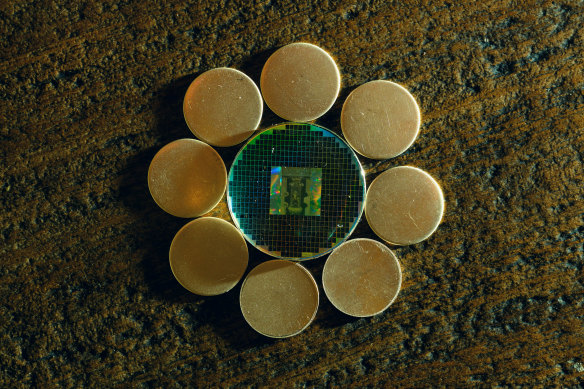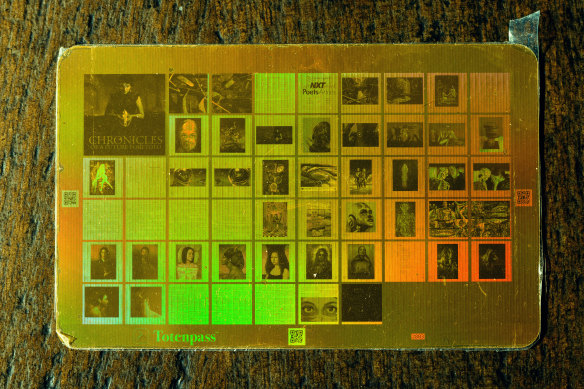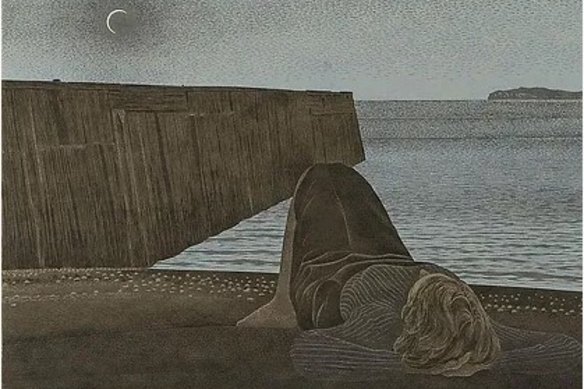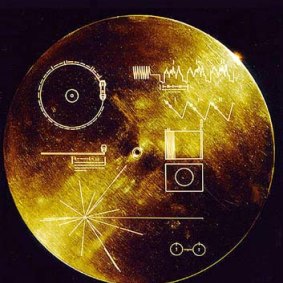
Save articles for later
Add articles to your saved list and come back to them any time.
New York: “Just keep telling the story”, says the director character in Wes Anderson’s latest film, Asteroid City, which takes a stylised look at mid-century America’s fascination with space and interstellar communications.
Later this year, the Lunar Codex – a vast multimedia archive telling a story of the world’s people through creative arts – will start heading for permanent installation on the moon aboard a series of unmanned rockets.
Isaac Asimov’s science-fiction novel “Foundation,” stored on a nickel-based NanoFiche disc surrounded by blank discs.Credit: Brendan George Ko/The New York Times
The Lunar Codex is a digitised (or miniaturised) collection of contemporary art, poetry, magazines, music, film, podcasts and books by 30,000 artists, writers, musicians and filmmakers in 157 countries. It’s the brainchild of Samuel Peralta, a semiretired physicist and author in Canada with a love of the arts and sciences.
Prints from war-torn Ukraine and poetry from countries threatened by climate change are in the Codex, as well as more than 130 issues of PoetsArtists magazine.
Among the thousands of images are New American Gothic, by Ayana Ross, the winner of the 2021 Bennett Prize for female artists; Emerald Girl, a portrait in Lego bricks by Pauline Aubey; and the aptly titled New Moon, a 1980 serigraph by Alex Colville.
Exhibition catalogs of artwork, miniaturised and etched onto nickel-based NanoFiche for a trip to the moon.Credit: Brendan George Ko/The New York Times
Some works were commissioned for the project, including The Polaris Trilogy: Poems for the Moon, a collection of poetry from every continent, including Antarctica.
An art collector and poet himself, Peralta, the executive chair of the Toronto-based media and technology company Incandence, has been reaching out to creators through gallery and publishing connections to select the works (and get archival permissions) for free inclusion in the Codex. He has also accepted works submitted by individual artists.
“This is the largest, most global project to launch cultural works into space,” Peralta said in an interview. “There isn’t anything like this anywhere.”
The Codex represents creators from a range of experiences. It includes several pieces from Connie Karleta Sales, an artist with the autoimmune disease neuromyelitis optica, who makes paintings using eye-gaze technology.
The image of New Moon by Alex Colville (1980) will be included in the Lunar Codex.
Electric Joy, one of the works, “celebrates the colour and movement of my mind,” Sales said in an email. “I might have limited use of my physical body, but my mind is limitless. It is dancing, laughing, crying and loving.”
Olesya Dzhurayeva, a Ukrainian printmaker, had evacuated from Kyiv in April 2022 in the first months of the Russian attack, when Peralta, who had previously purchased some of her work, contacted her with a supportive message. He also asked for her permission to archive images of several of her linocuts in the Lunar Codex, and she agreed.
“This project is so life-affirming with thoughts about the future,” she wrote in an email. “This is exactly what I needed in those first months.” A collection of her pieces are represented in the Codex, including a series of woodcuts printed with black Ukrainian soil.
The moon has hosted earthly art for decades.
Samuel Peralta, the creator of the Lunar Codex.Credit: Brendan George Ko/The New York Times
The Moon Museum, a tiny ceramic tile featuring line drawings by Forrest Myers, Andy Warhol, Claes Oldenburg, Robert Rauschenberg, David Novros and John Chamberlain, was discreetly attached to the leg of a lunar module left on the moon as part of the Apollo 12 mission in 1969.
Fallen Astronaut, an aluminum sculpture by Belgian artist Paul van Hoeydonck, was left on the lunar surface by the Apollo 15 crew in 1971, with a plaque commemorating 14 American astronauts and Soviet cosmonauts who died in scientific service to their countries.
Outside the Lunar Codex project, other contemporary artists are aiming to place solo works on the moon’s surface through commercial space travel, including Jeff Koons and British artist Sacha Jafri. The Arch Mission Foundation has sent Isaac Asimov’s Foundation trilogy and millions of Lunar Library pages into space.
But the Lunar Codex has bigger storytelling ambitions.
It’s divided into four time capsules, with its material copied onto digital memory cards or inscribed into nickel-based NanoFiche, a lightweight analog storage media that can hold 150,000 laser-etched microscopic pages of text or photos on one a sheet about A4 size.
A file photo released by NASA in 1970 shows the golden record on Voyager 1, launched on September 5, 1977, with a cartridge and a needle to play it.Credit: AFP/NASA
The concept is “like the Golden Record,” Peralta said, referring to NASA’s own cultural time capsule of audio and images stored on a metal disc and sent into space aboard the Voyager probes in 1977. “Gold would be incredibly heavy. Nickel wafers are much, much lighter.”
Peralta, a polymath who got his PhD in physics from the University of Wales, is the son of Filipino anthropologist/playwright Jesus T. Peralta and abstract artist Rosario Bitanga-Peralta. He started the Lunar Codex during the coronavirus pandemic to send his own work, including his science fiction books, to the moon before deciding to expand the scope.
He’s been compiling content for a few years, although some people he’s contacted haven’t taken him seriously. “I say, ‘I’d like to put your art on the moon,’ and they think this is some sort of a scam,” he said. His basic requirement for acceptance is that the artist or writer has been pre-curated by having work included in an exhibition, catalogue or anthology.
Peralta sees the Lunar Codex as “a message in the bottle for the future that during this time of war, pandemic and economic upheaval people still found time to create beauty”. And, for those who want to follow its travels, the Codex’s launch schedule and contents of each collection can be viewed at lunarcodex.com.
This article originally appeared in The New York Times.
Most Viewed in World
From our partners
Source: Read Full Article




